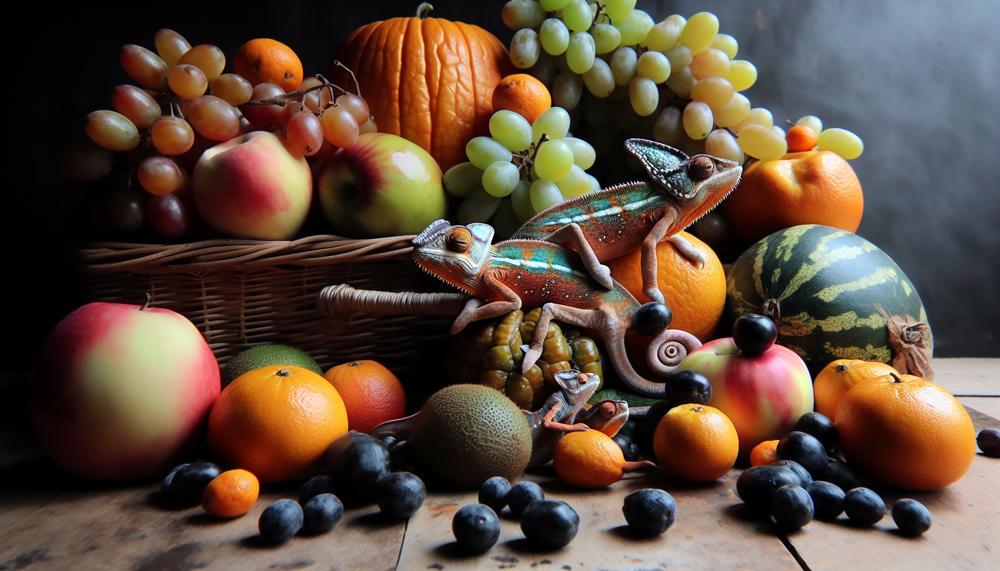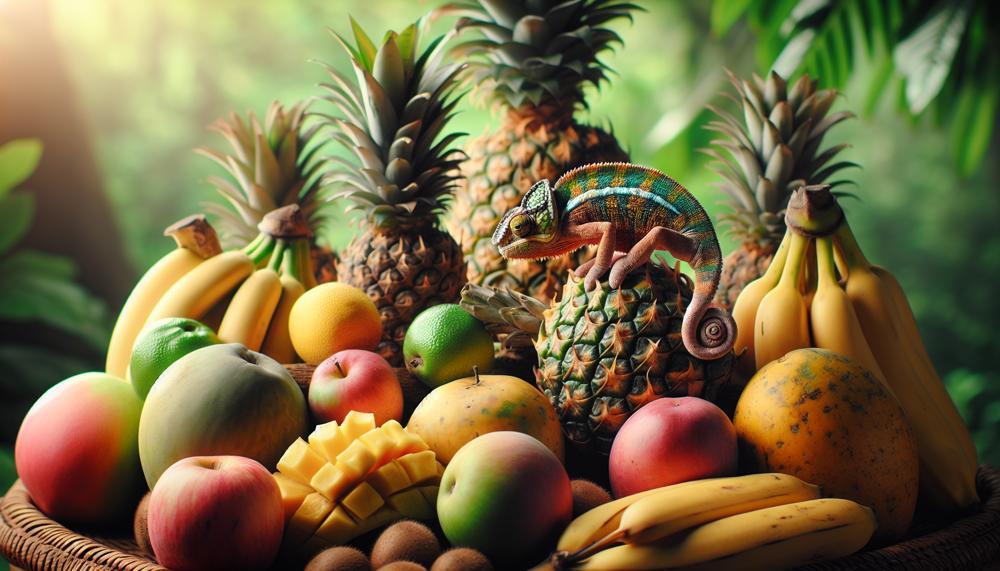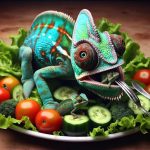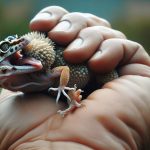Picture this: A vibrant chameleon is perched on a branch. Its long tongue darts out to catch a juicy piece of fruit. It’s a common image that many of us have seen in movies or TV shows, but is it really safe for chameleons to eat fruit? As with any pet, it’s important to know the facts before making any changes to their diet.
In this blog post, we’ll explore the safety of feeding fruits to chameleons. We’ll provide all the info you need to make informed decisions about your scaly friend’s nutrition.
So what exactly will we be covering in this post?
- The natural diet of chameleons and how fruit fits into it
- Potential health risks associated with feeding fruit
- Recommended fruits and how often they should be given
- Tips for safely introducing fruit into your chameleon’s diet
Whether you’re a new chameleon owner or have been caring for these unique creatures for years, it’s crucial to understand the role of fruit in their diet. So let’s dive into the juicy details.
Contents
Insects, Insects, Insects
For chameleons, it’s essential to feed them safe insects. These include crickets, grasshoppers, mealworms, and waxworms.
But before offering these insects to your pet, it’s crucial to prepare them properly. This includes gut-loading them with nutritious foods. You should also dust them with calcium and vitamin supplements. This will ensure their safety.
It’s also important to keep a close eye on your chameleon’s reaction to new foods. Consult a veterinarian if you have any concerns.
Maintaining a balanced diet is key to the health of chameleons. Offer a variety of leafy greens and fruits with safe insects. This provides necessary nutrients.
However, it’s important to note that not all fruits are safe for chameleons. For instance, citrus fruits like oranges and lemons can be too acidic for them and should be avoided.
Insects are an essential part of a chameleon’s diet as they provide necessary protein and other nutrients. However, it’s crucial to ensure their safety by properly preparing them before feeding.
Greens and Veggies
Chameleons are omnivores. They need a well-balanced diet of both insects and plants to stay healthy. They primarily feed on insects. However, adding a variety of greens and veggies to their diet can provide essential vitamins and minerals.
Here are some safe options to consider for your chameleon’s diet:
- Collard Greens
- Turnip Greens
- Mustard Greens
- Dandelion Leaves
- Papaya
- Watercress
- Kale
- Romaine Lettuce
- Carrots (as an occasional treat)
- Squash (as an occasional treat)
It is crucial to note that chameleons may have different eating habits. Some chameleons may not be interested in greens at all. In such cases, gut-loading insects with nutritious greens can still provide the necessary nutrients for their diet.
Dietary Supplements
Dietary supplements may seem beneficial for a chameleon’s diet. However, they are not essential and can even cause harm if overused. Chameleons are insectivores. They can get all their necessary nutrients from their natural diet of insects.
Excessive supplementation can cause toxicity and severe health problems. It is crucial to follow a proper feeding schedule. Provide a well-balanced diet mainly of insects.
Chameleons can safely eat fruits as part of their diet. However, they should be given in moderation. Chameleons do not have the enzymes needed to digest lots of fruits and plants. It’s important to limit their intake.
Fruits that are high in sugar should be avoided as they can lead to digestive issues. Safe options include apples, berries, and melons, which have low sugar content and high water content.
Can Chameleons Eat Fruit?

Chameleons are primarily carnivores and don’t need fruits and vegetables to survive. However, some chameleons may occasionally eat small amounts of fruit or nectar.
In captivity, a chameleon’s diet should feature variety. For example, veiled (Yemen) chameleons will eat fruit and veg. However, panther chameleons usually won’t.
Some fruits that you can feed your chameleon include: Apples, Bananas, Blackberries, Kiwi, Raspberries.
Feeding Mice to Chameleons – Yes or No?
While it is possible for chameleons to consume mice, it is not recommended to make them a regular part of their diet. This is because mice have a high-fat content. They are better as occasional treats or supplements for larger chameleons.
It’s also essential to consider your chameleon’s size. Smaller ones may struggle to catch or even eat mice.
| Size of Chameleon | Optimal Diet | Prey Size |
| Small | Insects with limited fruit intake | Fruit flies, small crickets, and other tiny insects |
| Medium | Insects with occasional treats/supplements | Medium-sized crickets, roaches, and worms |
| Large | Insects with occasional treats/supplements | Bigger crickets, roaches, and worms, as well as larger prey such as mice or small lizards |
Dietary supplements are not necessary for chameleons. They can even be harmful. Instead, focus on providing a well-rounded diet of insects with limited fruit intake.
Keep a close eye on your chameleon’s health. Seek veterinary advice immediately if any signs of malnutrition appear.
Keeping Your Chameleon Hydrated
To keep your chameleon hydrated, provide a variety of insects and fruits in their diet. This is crucial as chameleons primarily get their hydration from the food they eat.
By offering a variety of insects and fruits, you can ensure your pet is getting enough water intake.
Another way to keep your chameleon hydrated is by misting their enclosure regularly. This mimics their natural drinking process after rainfall. It also provides them with an extra source of hydration.
However, it’s essential to understand that not all fruits are suitable for chameleons. Many citrus fruits can be too acidic or bitter, which can cause your pet to avoid them. Also, remember to always cut out the seeds and cores of fruits as they can be toxic to reptiles.
In addition to providing a diverse diet, placing a shallow dish of water in the enclosure can help keep your chameleon hydrated. Some chameleons may drink directly from the dish. Others walk through it and lick the water droplets off their feet for hydration.
Monitoring their hydration levels is crucial for maintaining a hydrated chameleon. If you notice any signs of dehydration, such as sunken eyes or wrinkled skin, take immediate action. Provide more hydration through diet and mist the enclosure more frequently.
To summarize, here are the various ways to keep your chameleon hydrated through its diet:
- Offer a diverse range of insects and fruits
- Mist their enclosure regularly
- Provide a shallow dish of water
- Monitor hydration levels and take immediate action if signs of dehydration appear
Remember to provide a varied and nutritious diet for your chameleon. Always keep an eye on their hydration levels.
Foods to Avoid
When it comes to a chameleon’s diet, fruits are often seen as a good addition. However, there are certain fruits that should be avoided in order to maintain the health and well-being of these reptiles. Among the common fruits to avoid are citrus fruits, avocados, and grapes.
These fruits can cause digestive issues due to their high acidity levels. They also contain harmful toxins that can be fatal for chameleons.
Moreover, fruits with seeds or pits, like apples, peaches, and apricots, should also be kept away from these creatures as they can pose a danger.
Fruits have potential benefits. However, they should only make up a small portion of a chameleon’s diet. These reptiles should mainly eat gut-loaded insects and vegetables.
Introduce fruits slowly. Monitor their response carefully. This is crucial to avoid digestive problems or negative reactions.
When offering fruits to your chameleon, ensure they are organic and free of pesticides. This is important for their well-being.
Conclusion
In conclusion, it may seem common to see chameleons munching on fruit. However, it’s crucial to understand the facts and potential risks involved. Just like any other pet, it’s essential to provide chameleons with a well-balanced and nutritious diet. This diet should meet their unique dietary needs.
This means primarily feeding them gut-loaded insects. Incorporate safe fruits and leafy greens in moderation.
However, not all fruits are suitable for chameleons. Some can be too acidic or contain harmful toxins that can cause serious health issues.
It’s important to monitor your chameleon’s reaction to new foods. Seek professional advice if any concerns arise.






